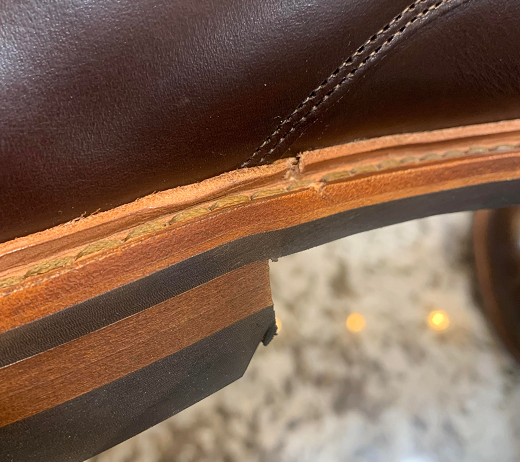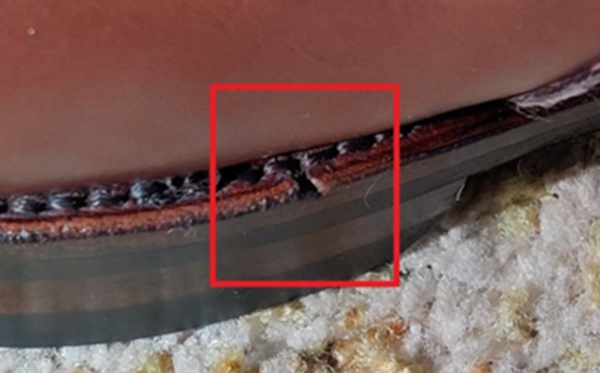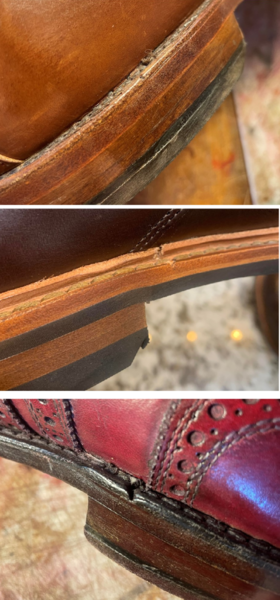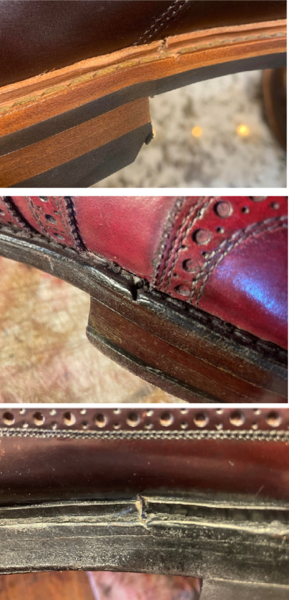Robert Powers
Member
- Joined
- Apr 21, 2018
- Messages
- 10
- Reaction score
- 53
I see what I would call a pleathora of posts mainly on the Facebook "Allen Edmonds Enthusiasts" group, and the Reddit sub-reddit r/allenedmonds, with people new to higher end shoes, asking if something they see as a problem is something they should return their shoes over. This post is meant to help clear the air on this issue. Of course the views stated here are mine, so you are free to disagree and act accordingly.
I'm Robert Powers, aka "Cobbler Bob". I've been running a YouTube channel since October of 2016, which currently has almost 14k subscribers. I like to find, repair, and polish old shoes. I currently own 28 pairs of dress shoes & boots, of which 12 pairs are Allen Edmonds. I haven't counted, but I've be bought, polished, and resold a few hundred pairs of shoes that mainly come from local thrift stores or eBay.
Premise: Have you been purchasing what I would call a "cheap" shoe, and finally decided to step up to a full grain Goodyear Welted shoe, only to have your heart sink when open the box because you found a flaw? First, what do I define as a "cheap" shoe? To me it's a shoe you'll probably pay $50-$150 for that probably has corrected grain or fake leather uppers, has a bonded on rubber sole, or has a sole that has the appearance of being stitched but isn't.
Allen Edmonds is often refeered to as the "gateway drug" to high end shoes. That reference means that they're generally not as high quality as true high end shoes like Crockett & Jones, Edward Green, TLB Mallorca Artista line, Gaziano & Girling, Magnanni, or even Alden, etc, but because they are often on sale, they are able to be purchased at a price point not out of reach for most people ($200-$350). So the question is, if I spent $50 to $150 dollars on a "cheap" shoe that's pretty much perfect looking out of the box every time, why when I spend $250 to $350 for a shoe like Allen Edmonds, why isn't it perfect every time?
The Wisconsin Shoeguy (YouTube: "Wi Shoeguy") said it best on a video interview on my channel: Allen Edmonds isn't so concerned with how the shoe looks out of the box, but they're more concerned with the longevity of the shoe. I agree.
Reason one: Shoes with Full Grain leather uppers and either 270 degree or 360 degree Goodyear Welted leather soles are made from natural materials. Corrected grain leather is cheap leather coated with some kind of polymer coating. This coating covers all flaws in the leather, and gives it a durable scuff resistant surface. In my experience though, all of the shoes made recently (since 2000-ish) of corrected grain leather outside the USA will crack and split. It also is not as breathable, and sometimes the coating wears off to reveal a lighter shade, and you can't re-color it with polish. With the full grain leather, you're seeing the actual surface of the animal's hide. It's coming from what was a breathing animal. Phil Kalas, owner of Ashland Leather Co told me in a "Leather Talk" interview that leather tanning is taking an inconsistent raw material, and trying to make a consistent end product. It's not easy! But when done right, the end product can last for decades with superior beauty.
Reason two: The soles of a cheap shoe are often a one piece injection molded sole with fake stitches molded in, and the heel even molded on. A step up from this is an injection molded sole made to look like leather, with a fake plastic welt. The welt will often have stitches on it, and the sole will have stitches on the bottom side, but the stitch count per inch is usually different from the bottom to the top, prooving that they don't acually hold anything on and are purely decorative.
"How to Spot FAKE Shoe Sole Stitching"video:
The GYW (Goodyear Welted) shoe sole must be cut, trimmed, grooved, stitched on, finished, then have (with AE) a 2 part heel base bonded and nailed on, then a top lift bonded on and finish sanded, then dyed to color. There are a lot more parts versus a standard shoe. AEs are not "hand made", they're machine made by a human operator, but the level of skill and number of steps taken are far greater than the cheap shoe. Therefore there are many more opportunities for small errors.
Problem #1: burnishing/patina irregularities:
Full grain leather, especially in the lighter shades is gorgeous. Walnut and ligher colors often have a burnishing applied (darkening at the tips of the toes, around the eye stays, and/or the sides of the vamp). With AE (Allen Edmonds) I believe this finishs is applied by hand with an airbrush. There can be inconsistencies with this finish, and it can have areas that are too dark or too inconsistent for your liking. Here is what it usually looks like: (pic 1)

Here is one you may not like: (pic 2)

notice it's more irregular, and the transition from dark to light is not as even. I'd be fine with the above,e especially if it was less than $300.
Here is pic #3, the heel on my AE Strands (the same shoe in pic #1):

Notice the dark to light sudden transition. I'm perfectly okay with it. Again, it's a natural material, and the irregularity is still beautiful to me. You can even this out if you'd like with a medium brown cream shoe polish. I paid $315 for them and I'm a-okay with it. I consider it character.
Problem #2: crazing/cracking of the burnishing, usually on the toes: (pic 4)

I am guessing that the finish either dried too quickly and contracted, or the toes were flattened at some point. Either way, with some darker cream polish the color of the burnishing, and a few coats of wax polish on the toes (I would mirror shine it) that should dissapear. I would not return this shoe, I'd be mirror shining the toes anyway.
Problem 3: Construction & Finishing issues:
If you get this, where the stitching goes off the welt, RETURN it. This is a major structural problem. These are my AE MacNeils that had to be returned to AE and a new welt and outsoles were put on. See pics #5/6 below:

This is also major. The black thread is the top thread, indicating impropper thread tension. Return it (pic 7)

This is minor. It's a piece of thread or leather trapped under the top welt stitch. Grab it with a pair of needle nose pliers and it should pull out. Now if the top thread is left loose, then you may want to return it, but I think this one would be fine. Pic 8 below:

These shoes have a turned up lip on the welt, called a split reverse welt. Notice the lip is smushed. See below pic 9/10:

Why do you have this on an expensive shoe and not a cheap one? Because most cheap shoes either don't have a welt at all, or if they do, it's not structural, and it's made of cheap injection molded plastic and has a costmetic only stitch, that although looks perfect every time, it will not last very long. Moisten the leather, and take a hard smooth object like the tip of a retractable pen or a pointed wooden dowel like a big chopstick or drumstick and smooth it back flat. It may not go back completely flat, but after it dries it will probably be smooth enought to not notice.
The sole stitch goes outside of the groove, like this in pic #11

This is a pair of AEs made in 2001. If this happens on the arch area where the threads won't contact the ground, let it go. It won't hurt anything. If the stitching on the sole is not 100% tidy, let it go. If this happends on the area where you walk, and the threads will break through prematurely, I'd return.
Minor scuffs out of the box, see pic #12/13 below:

95+% of the scuffs I see posted will go away with a little cream shoe polish. I'm a believer of polishing new shoes out of the box anyway, so it's no extra work for me. Remember, cheap corrected grain or fake leather has a plastic coating on the outside and is more scuff resistant. The downside to it though is when it does get scratched, it's harder to cover or correct. Full grain leather does show scuffs easier, but because of it's pliability and porousness, it readily accepts polish and conditioning creams better. You can polish out even light to moderate scratches, because the surface has no coating to abraid through. Polish these and move on, unless it's severe enought to where material has been removed.
This one is a cut, not a scratch, and it's on an area that is stressesd. RETURN without wearing it. See pic #14 below:

This next one, pic #15 below looks really bad for a new shoe. It appears as if someone poked holes through the upper. Believe it or not, but if you moisten the leather with moisturizer and rub it with a blunt object, like the blunt smooth end of a screwdriver handle, and back up the inside with your thumb, you can close those holes up to where polish will cover what's left. If I got a pair of AEs for LESS than $300 with these holes, and everything else was perfect, I'd burnish the holes shut as I stated above and be happy. If I paid full price and was not "handy", I would consider returning.

Problem area #4: Loose Grain:
Loose grain is a term to describe leather that is unusally wrinkly. It happens because the leather closer to the belly of the animal does not have the same properties as the areas closer to the spine and rump. Manufacturers are proabably trying to use more and more of the hyde to decrease material waste, and sometimes push it too far. In short, there is no fixing this, so decide quickly if you can live with it or not.
Remember, this may not show up until you walk in them. Here's MY OPINION of some to follow:
Pic #16, my AE Achesons I bought new from AE directly on sale for $97... loose grain on the left shoe. They were $97, I am fine with it. Now if they were $297, back they would go.

Pic #17/18: in my opinion, the boots on the left would be okay IF they were purchased on sale at a good price, but the Oxfords on the right are terrible and I'd return them at any price, especially since the person here said the other shoe was perfect, and this was after one wear:

I've saved the best for last... problem #5: THE WELT JOINT:
To understand this one, you must understand what a welt is, and why it must have a joint. Did you know an automotive tire is made from flat rubber? Every traditional tire has a joint. The welt is a flat piece of leather, and on a 360 degree GYW shoe, it wraps all the way around the shoe. It therefore has a starting and stopping point. The welt is stitched onto the insole via the gemming and to the upper. The welt is what the outsole of a GYW shoe is stitched too. Sometimes the welt joint is invisible, like pics #19 & #20 below:

Sometimes it's neat, but visible like these next three examples, #21, 22, 23:

FYI, that last photo directly above, #23, is from a pair of Florsheim shell cordovan 93605's made in the 1970's or 1980's:
These next two examples,pic #24/25 are not as neat, but 100% functional. Don't return them:

Does this make sense? Allen Edmonds says that their Goodyear Welted shoes go though 212 different manufacturing steps. It's a whole different animal than a "cheap shoe". Don't get me wrong, I'm not saying some of these errors are okay. I'm saying that if you buy a new Goodyear Welted shoe on sale for less than $300, or in some cases less than $250, do not expect to get the same quality as an $800 Church's or Crockett & Jones, or a $500 Alden that won't go on sale. So if these minor errors are too egregious for you to live with, you'll need to step up to the $450 and UP range for a pair of shoes.
Justin Fitzpatrick talks about the welt joint in his article on The Shoe Snob:
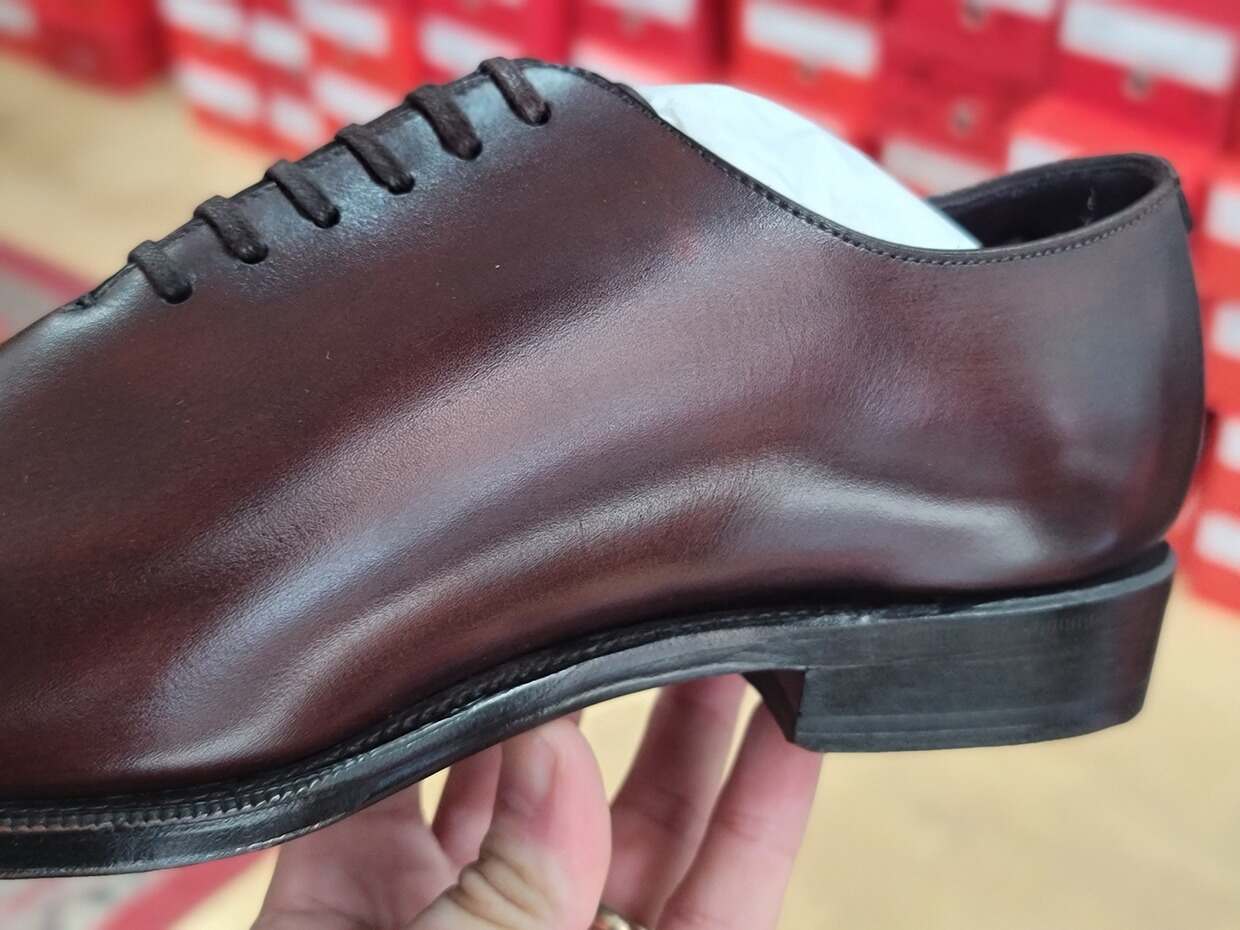
 theshoesnobblog.com
theshoesnobblog.com
I hope this helps, and here's a link to a video version of this article on my YouTube channel:
I'm Robert Powers, aka "Cobbler Bob". I've been running a YouTube channel since October of 2016, which currently has almost 14k subscribers. I like to find, repair, and polish old shoes. I currently own 28 pairs of dress shoes & boots, of which 12 pairs are Allen Edmonds. I haven't counted, but I've be bought, polished, and resold a few hundred pairs of shoes that mainly come from local thrift stores or eBay.
Premise: Have you been purchasing what I would call a "cheap" shoe, and finally decided to step up to a full grain Goodyear Welted shoe, only to have your heart sink when open the box because you found a flaw? First, what do I define as a "cheap" shoe? To me it's a shoe you'll probably pay $50-$150 for that probably has corrected grain or fake leather uppers, has a bonded on rubber sole, or has a sole that has the appearance of being stitched but isn't.
Allen Edmonds is often refeered to as the "gateway drug" to high end shoes. That reference means that they're generally not as high quality as true high end shoes like Crockett & Jones, Edward Green, TLB Mallorca Artista line, Gaziano & Girling, Magnanni, or even Alden, etc, but because they are often on sale, they are able to be purchased at a price point not out of reach for most people ($200-$350). So the question is, if I spent $50 to $150 dollars on a "cheap" shoe that's pretty much perfect looking out of the box every time, why when I spend $250 to $350 for a shoe like Allen Edmonds, why isn't it perfect every time?
The Wisconsin Shoeguy (YouTube: "Wi Shoeguy") said it best on a video interview on my channel: Allen Edmonds isn't so concerned with how the shoe looks out of the box, but they're more concerned with the longevity of the shoe. I agree.
Reason one: Shoes with Full Grain leather uppers and either 270 degree or 360 degree Goodyear Welted leather soles are made from natural materials. Corrected grain leather is cheap leather coated with some kind of polymer coating. This coating covers all flaws in the leather, and gives it a durable scuff resistant surface. In my experience though, all of the shoes made recently (since 2000-ish) of corrected grain leather outside the USA will crack and split. It also is not as breathable, and sometimes the coating wears off to reveal a lighter shade, and you can't re-color it with polish. With the full grain leather, you're seeing the actual surface of the animal's hide. It's coming from what was a breathing animal. Phil Kalas, owner of Ashland Leather Co told me in a "Leather Talk" interview that leather tanning is taking an inconsistent raw material, and trying to make a consistent end product. It's not easy! But when done right, the end product can last for decades with superior beauty.
Reason two: The soles of a cheap shoe are often a one piece injection molded sole with fake stitches molded in, and the heel even molded on. A step up from this is an injection molded sole made to look like leather, with a fake plastic welt. The welt will often have stitches on it, and the sole will have stitches on the bottom side, but the stitch count per inch is usually different from the bottom to the top, prooving that they don't acually hold anything on and are purely decorative.
"How to Spot FAKE Shoe Sole Stitching"video:
The GYW (Goodyear Welted) shoe sole must be cut, trimmed, grooved, stitched on, finished, then have (with AE) a 2 part heel base bonded and nailed on, then a top lift bonded on and finish sanded, then dyed to color. There are a lot more parts versus a standard shoe. AEs are not "hand made", they're machine made by a human operator, but the level of skill and number of steps taken are far greater than the cheap shoe. Therefore there are many more opportunities for small errors.
Problem #1: burnishing/patina irregularities:
Full grain leather, especially in the lighter shades is gorgeous. Walnut and ligher colors often have a burnishing applied (darkening at the tips of the toes, around the eye stays, and/or the sides of the vamp). With AE (Allen Edmonds) I believe this finishs is applied by hand with an airbrush. There can be inconsistencies with this finish, and it can have areas that are too dark or too inconsistent for your liking. Here is what it usually looks like: (pic 1)
Here is one you may not like: (pic 2)
notice it's more irregular, and the transition from dark to light is not as even. I'd be fine with the above,e especially if it was less than $300.
Here is pic #3, the heel on my AE Strands (the same shoe in pic #1):
Notice the dark to light sudden transition. I'm perfectly okay with it. Again, it's a natural material, and the irregularity is still beautiful to me. You can even this out if you'd like with a medium brown cream shoe polish. I paid $315 for them and I'm a-okay with it. I consider it character.
Problem #2: crazing/cracking of the burnishing, usually on the toes: (pic 4)
I am guessing that the finish either dried too quickly and contracted, or the toes were flattened at some point. Either way, with some darker cream polish the color of the burnishing, and a few coats of wax polish on the toes (I would mirror shine it) that should dissapear. I would not return this shoe, I'd be mirror shining the toes anyway.
Problem 3: Construction & Finishing issues:
If you get this, where the stitching goes off the welt, RETURN it. This is a major structural problem. These are my AE MacNeils that had to be returned to AE and a new welt and outsoles were put on. See pics #5/6 below:
This is also major. The black thread is the top thread, indicating impropper thread tension. Return it (pic 7)
This is minor. It's a piece of thread or leather trapped under the top welt stitch. Grab it with a pair of needle nose pliers and it should pull out. Now if the top thread is left loose, then you may want to return it, but I think this one would be fine. Pic 8 below:
These shoes have a turned up lip on the welt, called a split reverse welt. Notice the lip is smushed. See below pic 9/10:
Why do you have this on an expensive shoe and not a cheap one? Because most cheap shoes either don't have a welt at all, or if they do, it's not structural, and it's made of cheap injection molded plastic and has a costmetic only stitch, that although looks perfect every time, it will not last very long. Moisten the leather, and take a hard smooth object like the tip of a retractable pen or a pointed wooden dowel like a big chopstick or drumstick and smooth it back flat. It may not go back completely flat, but after it dries it will probably be smooth enought to not notice.
The sole stitch goes outside of the groove, like this in pic #11
This is a pair of AEs made in 2001. If this happens on the arch area where the threads won't contact the ground, let it go. It won't hurt anything. If the stitching on the sole is not 100% tidy, let it go. If this happends on the area where you walk, and the threads will break through prematurely, I'd return.
Minor scuffs out of the box, see pic #12/13 below:
95+% of the scuffs I see posted will go away with a little cream shoe polish. I'm a believer of polishing new shoes out of the box anyway, so it's no extra work for me. Remember, cheap corrected grain or fake leather has a plastic coating on the outside and is more scuff resistant. The downside to it though is when it does get scratched, it's harder to cover or correct. Full grain leather does show scuffs easier, but because of it's pliability and porousness, it readily accepts polish and conditioning creams better. You can polish out even light to moderate scratches, because the surface has no coating to abraid through. Polish these and move on, unless it's severe enought to where material has been removed.
This one is a cut, not a scratch, and it's on an area that is stressesd. RETURN without wearing it. See pic #14 below:
This next one, pic #15 below looks really bad for a new shoe. It appears as if someone poked holes through the upper. Believe it or not, but if you moisten the leather with moisturizer and rub it with a blunt object, like the blunt smooth end of a screwdriver handle, and back up the inside with your thumb, you can close those holes up to where polish will cover what's left. If I got a pair of AEs for LESS than $300 with these holes, and everything else was perfect, I'd burnish the holes shut as I stated above and be happy. If I paid full price and was not "handy", I would consider returning.
Problem area #4: Loose Grain:
Loose grain is a term to describe leather that is unusally wrinkly. It happens because the leather closer to the belly of the animal does not have the same properties as the areas closer to the spine and rump. Manufacturers are proabably trying to use more and more of the hyde to decrease material waste, and sometimes push it too far. In short, there is no fixing this, so decide quickly if you can live with it or not.
Remember, this may not show up until you walk in them. Here's MY OPINION of some to follow:
Pic #16, my AE Achesons I bought new from AE directly on sale for $97... loose grain on the left shoe. They were $97, I am fine with it. Now if they were $297, back they would go.
Pic #17/18: in my opinion, the boots on the left would be okay IF they were purchased on sale at a good price, but the Oxfords on the right are terrible and I'd return them at any price, especially since the person here said the other shoe was perfect, and this was after one wear:
I've saved the best for last... problem #5: THE WELT JOINT:
To understand this one, you must understand what a welt is, and why it must have a joint. Did you know an automotive tire is made from flat rubber? Every traditional tire has a joint. The welt is a flat piece of leather, and on a 360 degree GYW shoe, it wraps all the way around the shoe. It therefore has a starting and stopping point. The welt is stitched onto the insole via the gemming and to the upper. The welt is what the outsole of a GYW shoe is stitched too. Sometimes the welt joint is invisible, like pics #19 & #20 below:
Sometimes it's neat, but visible like these next three examples, #21, 22, 23:
FYI, that last photo directly above, #23, is from a pair of Florsheim shell cordovan 93605's made in the 1970's or 1980's:
These next two examples,pic #24/25 are not as neat, but 100% functional. Don't return them:
Does this make sense? Allen Edmonds says that their Goodyear Welted shoes go though 212 different manufacturing steps. It's a whole different animal than a "cheap shoe". Don't get me wrong, I'm not saying some of these errors are okay. I'm saying that if you buy a new Goodyear Welted shoe on sale for less than $300, or in some cases less than $250, do not expect to get the same quality as an $800 Church's or Crockett & Jones, or a $500 Alden that won't go on sale. So if these minor errors are too egregious for you to live with, you'll need to step up to the $450 and UP range for a pair of shoes.
Justin Fitzpatrick talks about the welt joint in his article on The Shoe Snob:

Welt Joining - Good vs Bad
A seamless joining With the influx of Spanish private labeling (factories making for other brands) and Latin American shoemakers (Mexico, Argentina, Colombia etc), I am starting to see a lot of questions/complaints about the joining
I hope this helps, and here's a link to a video version of this article on my YouTube channel:
Attachments
Last edited:
